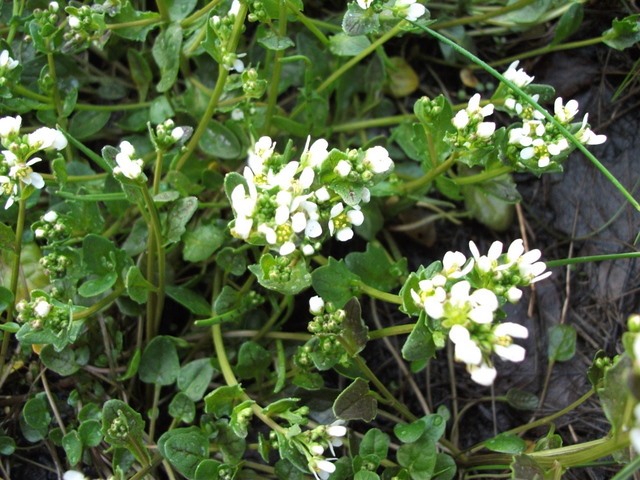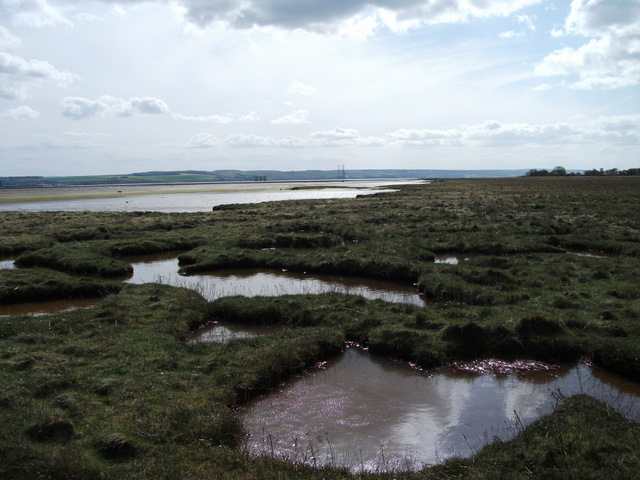Last week, I was getting up with the lark, quite literally, as the skylarks were in full voice when I reached the saltmarsh in the hours shortly after dawn (which in the north of Scotland is about 4.45am at the moment!). Spring has definitely sprung on the saltmarsh, the common scurvygrass and thrift are starting to flower, and the birds are preparing to nest. This is why I have been out on the saltmarsh in the early mornings, as over April and May I shall be surveying redshank and shelduck, two bird species which use the saltmarsh and its adjacent mudflat habitats to breed and feed. I will be studying the vegetation and invertebrates of saltmarsh later in the year, as well as wintering bird numbers, but April and May are the vital times for surveying breeding birds.
Redshank are medium sized wading birds, with bright red legs, which nest on inland wetlands and farmland, as well as saltmarsh. They nest in tussocky patches and feed on invertebrates in the saltmarsh’s muddy pools and creeks and adjacent mudflats. Pressure on inland wetlands and farmlands, mean that redshank are becoming more reliant on saltmarsh for breeding. Saltmarsh throughout Britain is itself under threat from a variety of pressures including –
Pollution
Climate change – in particular rising sea levels
Coastal squeeze – as the saltmarsh is decreased by erosion as it is stuck between hard sea defences and rising sea levels
Increasing domination of some invasive species.
Redshank are an amber listed species in terms of European Conservation Status, meaning that their breeding population has seen a decline of 25-50% in the past 25 years. I am conducting redshank surveys on saltmarsh sites in the Cromarty Firth, to develop a picture of the current breeding status of the birds on the saltmarsh in the area. Many of the sites that I am working on, were also surveyed in UK-wide Saltmarsh Redshank breeding surveys conducted by the RSPB in 1985 and 1996, meaning that I will be able to highlight any changes in breeding populations over recent time. Redshank, are best surveyed shortly after dawn, as this is when they are most active, reaffirming their territories by conducting display flights and calling. Unfortunately, I have not had many redshank to record so far, but I have been treated to amazing sights and saltmarsh spectacles, including flocks of over 300 pink-footed geese, the song of the skylark which never loses its appeal, and the sun and the mist rising over the saltmarshes of the Cromarty Firth.
This week I have also started conducting shelduck surveys. Shelduck are large ducks, who actually have much more in common with the goose family. They can appear black and white when flying, but they are actually a very striking bird, with a green head, a chestnut breast band, with further green and black markings on their wings and a prominent red bill, with the male developing a distinctive fleshy red knob on the top of its bill in the early spring. There are thought to be around 10,900 pairs of shelduck breeding in the UK, and my survey results will allow us to develop a picture of how many are breeding on the RSPB’s north Scotland saltmarsh reserves of Nigg Bay, Udale Bay and Culbin Sands. Shelduck pairs develop territories at their feeding grounds on the mudflats adjacent to the saltmarsh, rather than at their actual nesting sites that are usually further in land and where they will tolerate other pairs nesting close by, and so it is from the saltmarsh that you count them. Shelduck feed on the invertebrates in the mudflats, and have some pretty imaginative ways of ensuring they get their fill, including foot trampling to bring their prey closer to the surface! The surveys involve mapping the locations of territorial pairs (where the female is taking a break from egg laying or incubating), territorial males (where the female is on the nest incubating the eggs) and groups (these will be non-breeders this year). So far, I am getting good results with initial surveys indicating between four and eleven territories on each of the reserves, each site will be surveyed twice more before I can fully analyse the data. It is great to be out surveying the birds and gaining a greater understanding of how the ecosystem in terms of the habitat, the invertebrates, the vegetation and the birds all tie in together…the only problem is that I keep seeing shelduck on my redshank surveys, and redshank on my shelduck surveys…!
Other things that I have been doing include
• learning a lot more about saltmarsh habitat in general. They are very dynamic ecosystems, characterised by unique vegetation that can cope with being inundated by salt water, sometimes on a twice daily basis. The vegetation develops in zones according the various plants tolerance of the salt water – creating low, middle and upper salt marsh communities. Saltmarsh is a fragile habitat that is difficult to replace once it is lost.
• visiting Meddat, at Nigg Bay, the location of first coastal realignment site in Scotland when it was undertaken in 2003. Here, the sea wall has been breached in two places, allowing salt water to once again inundate the field beyond twice daily as it would have done naturally, before the construction of the seawall in the 1950s. I will be undertaking vegetation, bird and invertebrate surveying at the site after the bird surveys are done, to enable us to see how the saltmarsh in the field is developing eight years on . It is a very exciting site and project, and similar projects have been undertaken in England and Scotland, however, the formation or re-establishment of saltmarsh is not yet able to keep pace with the amount that we are losing.
• Gaining my pesticide qualification, to enable me to tackle some of the invasive species such as Spartina, giant hogweed and Japanese knotweed, that are invading the saltmarsh.
• Mapping the edge of the saltmarsh at Nigg and Udale Bay using GPS, and then uploading the data onto GIS software to enable us to see where the saltmarsh is eroding and accreting. This involves walking exactly along the edge of the saltmarsh, which is usually frilly, winding and irregular, which has got me some strange looks from people visiting the hides!
• Having my first glimpses of the young fish that use the creeks and pools of the saltmarsh to grow in, they are relatively more safe developing here than in the open estuary, apart from when there is a heron standing in the pool! I have also had my first glimpses of Hydrobia ulvae, a tiny mollusc, some only a couple of millimetres long, that lives in saltmarshes and I’m sure will feature regularly in my invertebrate surveys.
• Finally, I have also discovered that as the name suggests, mudflats are indeed very muddy!
Claire Foot
BTCV Natural Talent Saltmarsh Apprentice
Common scurvygrass


Saltmarsh at Nigg Bay
